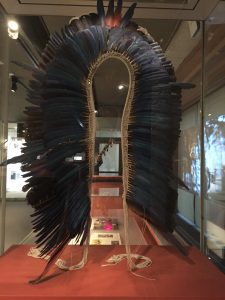For this week’s blog, I will be focusing on the “Amazonia: The Rights of Nature” exhibit that has been (and will be!) residing in the Museum of Anthropology from March 10, 2017 until January 28, 2018. The exhibit is curated by Nuno Porto, and its mandate explains that the exhibit “seeks to raise awareness of the knowledge, aesthetics, and sensibilities of the many peoples of the Amazonia and to draw attention to the current state of inbalance” (Porto). The exhibit hosts a wide variety of primary materials, such as headdresses, bowls, loin clothes, masks and hammocks. Each object is put on display with an accompanying description, usually explaining what the objects are, how they were used/made or how they were collected. For me, this exhibit was a very interesting and informative experience and I left with a much greater understanding of the peoples of the Amazon’s past, and current ways of life. Although, the exhibit did make me wonder as to why I hadn’t been exposed to these peoples beforehand, as it was brought to the forefront within the exhibit that the people’s, as well as the Amazon itself are being threatened due to resource extraction industries (Porto). It was shocking to me that I had not seen much media coverage surrounding this issue (I watch the news regularly), especially because indigenous rights are often considered to be a very important issue within Canada. The exhibit’s mandate, specifically “…to draw attention to the current state of imbalance”, seems to hint towards acts of exclusion from the mainstream media, therefore creating the need to direct attention, and a disproportionate division of something, (I would guess power) (Porto). I will examine this idea in more detail later on in the post.
For this discussion, I will be choosing to examine a headdress that was showcased within the exhibit, and more specifically, the caption that accompanied it:

The headdress is between three and four feet tall and consisted of blue, black and red feathers placed around a headband woven out of some sort of rope. It is typically worn by children on special occasions, for example during naming ceremonies (Kahn Academy). Underneath the headdress, the caption describes a trip to Brazil, presumably when the headdress was collected, which was taken by Vancouver resident Linda Alexandre, accompanied by Dr.Cullis, and her husband David Suzuki, “to support the Kayapo or Mebêngôkre in their struggle against a hydroelectric dam project in Altamira, in the Xingu valley”(Porto). The description also acknowledges that although the World Bank ceased to fund the project, the plans were reinstated in the early 2000s; it is noted that “the effects on the people living in the Xingu valley were devastating” (Porto). This reminds me of an ongoing problem in Vancouver, as currently “seven First Nations… are asking the court to overturn the federal government’s decision to approve the expansion of the… [trans-mountain] pipeline from Edmonton to Burnaby” (CBC). These two issues, although seemingly unrelated, work together to show how indigenous rights are still, even today, often being pushed aside, and how everyone needs to work to protect these historically vulnerable, and marginalized groups, and emphasizes how Vancouver residents could possibly be connected to the peoples of the Amazon, as we deal, and struggle with similar issues (albeit on seemingly opposite ends). When reflecting on this exhibit, I find it most useful to refer to the disciplinary lens of political science. Because of the ways in which the discipline looks at relationships between civilians and governments, I was able to critically analyse the way the Amazon peoples had been maltreated, presumably due in part to flaws within their government’s actions and policies. I think this exhibit can really be used as a comment on power and power dynamics, especially when considering the role, and treatment of subordinate groups, of which is a big part of the study of politics. The fact that until now, I had been relatively in the dark about these people’s and their struggles, could serve to illustrate Carter’s reflections regarding archival silences, within his article “Of Things Said and Unsaid: Power, Archival silences, and Power in Silence”. Cater examines how the purposeful exclusion of voices, as well as a group’s deliberate choice to remain silent, can be situations in which power can be covertly wielded (216). It is unarguable that the mainstream media sets its own agenda and the fact that I watched, and continue to watch the national news almost nightly, without having ever heard of these groups and their struggles before, further speaks to the fact that topics that could be considered unsavory, such as protesting and speaking out against authority and government, are often excluded from the narrative that the media actively continues to edit.
Works Cited
Porto, Nuno, curator. Amazonia: The Rights of Nature. 2017. Museum of Anthroplogy. Vancouver, BC.
Khan Academy, The British Museum, 25 Nov. 2014, www.khanacademy.org/humanities/art-americas/south-america-early/amazonian-people/v/kayap-headdress-a-glimpse-of-life-in-the-amazon-rainforest.
News, CBC. “First Nations begin court challenge against Trans Mountain pipeline.” CBCnews, CBC/Radio Canada, 2 Oct. 2017, www.cbc.ca/news/canada/british-columbia/trans-mountain-kinder-morgan-court-first-nations-1.4316928.
Carter, Rodney. “Of Things Said and Unsaid: Power, Archival Silences, and Power in Silence.” Archivaria [Online], 61 (2006): n. pag. Web. 16 Jan. 2018